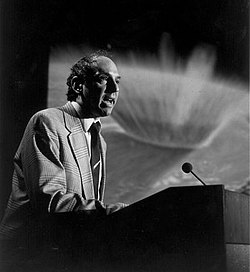Winners
Recipients of the award have been: [5]
| Year | Name | Nationality | Field | Notes |
|---|---|---|---|---|
| 1979 | James McMahon | | Occultations | [3] |
| 1980 | Frank Bateson | | Variable stars | [6] |
| 1981 | George Alcock | | Novae/Comets | [7] |
| 1982 | Ben Mayer | | Problicom | [8] [9] |
| 1983 | J. U. Gunter | | Asteroids | [10] [11] |
| 1984 | Russell Genet | | Photoelectric photometry | [12] |
| 1985 | Gregg Thompson & Robert Evans | | Supernovae | [13] [14] |
| 1986 | Jean Meeus | | Computational astronomy | [15] [16] |
| 1987 | Clinton B. Ford | | Variable stars | [17] |
| 1988 | Jack B. Newton | | Astrophotography | [18] |
| 1989 | Paul Baize | | Double stars | [19] |
| 1990 | Oscar Monnig | | Meteorites | [20] |
| 1991 | Otto Kippes | | Asteroid orbits | [21] |
| 1992 | Richard Lines & Helen Lines | | Photoelectric photometry of variable stars | [22] |
| 1993 | David H. Levy | | Comets | [23] |
| 1994 | Walter H. Haas | | ALPO founder | [4] |
| 1995 | Donald Parker | | Planetary imaging | [4] |
| 1996 | M. Daniel Overbeek | | Variable stars | [24] |
| 1997 | Edward A. Halbach | | Variable stars/occultations | [25] |
| 1998 | Albert F. A. L. Jones | | Variable stars/comets | [26] |
| 1999 | Warren Offutt | | Trans-Neptunian objects | [27] |
| 2000 | Paul Boltwood | | Deep-sky imaging/Comet Hyakutake | [28] |
| 2001 | Syuichi Nakano | | Computing comet orbits | [29] |
| 2002 | No award | |||
| 2003 | Kyle E. Smalley | | Near-Earth asteroids | [30] |
| 2004 | Nik Szymanek | | Imaging and image processing | [31] |
| 2005 | Tim Hunter | | Light pollution | [32] |
| 2006 | Kamil Hornoch | | Visual and CCD observations of variable stars/comets | [33] |
| 2007 | Peter Francis Williams | | R Coronae Borealis stars/variable star monitoring | [34] |
| 2008 | Steve Mandel | | CCD imaging | [35] |
| 2009 | Thomas Droege | | Developing CCD instrumentation and a worldwide sky survey program | [36] |
| 2010 | Allan Rahill | | Adapted Canadian Meteorological Centre forecast products for the purpose of planning observing sessions with highly accurate high resolution point forecasts of cloud cover, transparency, seeing, darkness, wind, temperature and humidity over North and Central America | [37] |
| 2011 | Kevin Apps | | Advancing the fields of extra-solar planet research and stellar astrophysics | [38] |
| 2012 | Jeffrey L. Hopkins | | Photoelectric photometry and high-resolution spectroscopy | [39] |
| 2013 | No award | |||
| 2014 | Rod Stubbings | | Instrumental in helping redefine the Z Cam sub-type of dwarf novae, and discovered the recurrent nova V745 Sco in outburst in the morning sky, triggering an AAVSO Alert Notice and significant attention from the astronomical community | [40] |
| 2015 | No award | |||
| 2016 | No award | |||
| 2017 | Gao Xing | | Supernovae/Comets | [41] |
| 2018 | Thiam-Guan Tan | | Exoplanets | [42] |
| 2019 | No award | |||
| 2020 | No award | |||
| 2021 | No award | |||
| 2022 | Paul D. Maley | | Solar eclypses, divulgation, occultations | [43] |


